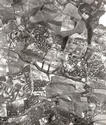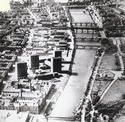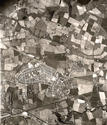Neighbourhoods
By Irene Maver
 Although Glasgow's territory more than doubled in size during the inter-war period, reaching 16,077 hectares (over 62 square miles) by 1938, there was no further boundary expansion until 1975. Nevertheless, there was sustained building development in the newly acquired districts from the late 1940s, while an ambitious comprehensive development programme transformed several of the older neighbourhoods. Thousands of Glaswegians were also moved to new towns and overspill areas outside the city, in the quest to relieve urban congestion. Population statistics reveal the extent of social change; by 1974 there was an estimated 816,000 city dwellers, indicating a loss of over 310,000 people since 1938.
Although Glasgow's territory more than doubled in size during the inter-war period, reaching 16,077 hectares (over 62 square miles) by 1938, there was no further boundary expansion until 1975. Nevertheless, there was sustained building development in the newly acquired districts from the late 1940s, while an ambitious comprehensive development programme transformed several of the older neighbourhoods. Thousands of Glaswegians were also moved to new towns and overspill areas outside the city, in the quest to relieve urban congestion. Population statistics reveal the extent of social change; by 1974 there was an estimated 816,000 city dwellers, indicating a loss of over 310,000 people since 1938.
The Glasgow Clearances
 Regional planning strategy underpinned the so-called "Glasgow Clearances". Originating in the optimistic climate of reconstruction towards the end of the Second World War, the Clyde Valley Regional Plan had been commissioned by Thomas Johnston (1881-1965), Secretary of State for Scotland. The aim was systematically to tackle the complex social and economic problems of a vast area which covered five counties as well as the city. Sir Patrick Abercrombie (1879-1957), a distinguished planning expert, prepared the Clyde Valley Report of 1946, which identified the need to disperse between 250,000 to 300,000 people from central Glasgow.
Regional planning strategy underpinned the so-called "Glasgow Clearances". Originating in the optimistic climate of reconstruction towards the end of the Second World War, the Clyde Valley Regional Plan had been commissioned by Thomas Johnston (1881-1965), Secretary of State for Scotland. The aim was systematically to tackle the complex social and economic problems of a vast area which covered five counties as well as the city. Sir Patrick Abercrombie (1879-1957), a distinguished planning expert, prepared the Clyde Valley Report of 1946, which identified the need to disperse between 250,000 to 300,000 people from central Glasgow.
 While "breathing space" had been a municipal objective since the early 19th century, Corporation leaders were initially uncomfortable at the prospect of losing such a huge proportion of the population base. However, there was also intense political pressure to ease overcrowding levels and provide better housing. To this end, a wide-ranging redevelopment plan was initiated during the 1950s, with twenty-nine districts targeted for demolition and renewal. The Hutchesontown-Gorbals Comprehensive Development Area (CDA) was the first to be formally approved in 1957 and soon became a well-publicised example of Glaswegian determination to transform the urban landscape.
While "breathing space" had been a municipal objective since the early 19th century, Corporation leaders were initially uncomfortable at the prospect of losing such a huge proportion of the population base. However, there was also intense political pressure to ease overcrowding levels and provide better housing. To this end, a wide-ranging redevelopment plan was initiated during the 1950s, with twenty-nine districts targeted for demolition and renewal. The Hutchesontown-Gorbals Comprehensive Development Area (CDA) was the first to be formally approved in 1957 and soon became a well-publicised example of Glaswegian determination to transform the urban landscape.
Inner City Redevelopment
 In the long term, the CDA programme aimed to clear almost 100,000 dwellings and relocate 60 per cent of the affected population elsewhere. Some were moved to new communities within the city boundaries, notably the four peripheral "townships" of Castlemilk, Drumchapel, Easterhouse and Pollok. Yet because of the sheer scale of the housing crisis, dispersal strategy involved communities beyond the city limits. This had been a recommendation of the Clyde Valley Report, which proposed that the new towns of East Kilbride in Lanarkshire, and Cumbernauld in Dunbartonshire, should provide homes for city families. By the 1960s the movement of Glaswegians was extending even further, for instance to Fife and the Lothians.
In the long term, the CDA programme aimed to clear almost 100,000 dwellings and relocate 60 per cent of the affected population elsewhere. Some were moved to new communities within the city boundaries, notably the four peripheral "townships" of Castlemilk, Drumchapel, Easterhouse and Pollok. Yet because of the sheer scale of the housing crisis, dispersal strategy involved communities beyond the city limits. This had been a recommendation of the Clyde Valley Report, which proposed that the new towns of East Kilbride in Lanarkshire, and Cumbernauld in Dunbartonshire, should provide homes for city families. By the 1960s the movement of Glaswegians was extending even further, for instance to Fife and the Lothians.
 Inevitably there were immense changes to neighbourhoods within the city. Between 1961 and 1971 the municipal wards of Anderston, Kingston and Townhead declined in population by more than half. At the same time the combined Gorbals and Hutchesontown wards fell from nearly 45,000 inhabitants to just over 19,000. The inner city was particularly affected by the outflow, although population loss was countered to some extent by the trend for high-density building, in the form of multi-storey developments. The 20-storey tower blocks erected by the Corporation at Sighthill represented a telling symbol of changing industrial fortunes, as they were built on the site of the once renowned St Rollox chemical works.
Inevitably there were immense changes to neighbourhoods within the city. Between 1961 and 1971 the municipal wards of Anderston, Kingston and Townhead declined in population by more than half. At the same time the combined Gorbals and Hutchesontown wards fell from nearly 45,000 inhabitants to just over 19,000. The inner city was particularly affected by the outflow, although population loss was countered to some extent by the trend for high-density building, in the form of multi-storey developments. The 20-storey tower blocks erected by the Corporation at Sighthill represented a telling symbol of changing industrial fortunes, as they were built on the site of the once renowned St Rollox chemical works.
Greater Glasgow
The post-war planning schemes arose from central government concern to improve living standards and promote economic growth. In this context, Scotland's traditional local government system was seen as anachronistic, with a multiplicity of authorities and inadequate co-ordination of resources. A Royal Commission suggested radical reform in 1969, and by the early 1970s proposals had been put forward for change. Echoing the ideas contained in the Clyde Valley Report, Glasgow was to form the core of a vast "west" region, stretching from Argyllshire to Ayrshire.
Within Strathclyde, as the region became known, the government aimed to double the city's territory to 38,300 hectares (nearly 148 square miles), thus increasing the population to nearly 1,150,000. There were echoes of the previous boundary extension of 1926, which had attempted - largely unsuccessfully - to incorporate middle-class suburbs such as Bearsden, in Dunbartonshire. However, the 1970s "Greater Glasgow" was far more ambitious, targeting populous industrial communities like Clydebank, also in Dunbartonshire. It was even envisaged that the city would include affluent Strathblane in Stirlingshire. The intention was to make Glasgow a more balanced urban entity in terms of wealth and social class, while at the same time boosting much-needed taxation revenue.
As in the 1920s a furious political row ensued over the city's administrative boundaries and resistance to the Glasgow connection crossed party lines. Most of the outlying communities successfully stood their ground and Glasgow was extended only to 20,235 hectares (a little over 78 square miles) in 1975. Ironically, the proposed "Greater Edinburgh" was allowed to proceed, which meant that Scotland's capital far exceeded Glasgow in size, at over 26,000 hectares (more than 100 square miles).
The enlarged Glasgow took in populous neighbourhoods to the east including Baillieston and Mount Vernon, villages that had grown with the rise of the Lanarkshire mining industry. Cambuslang and Rutherglen, in the southeast, were also controversially added. There was a community of interest between the two neighbourhoods, given their shared economic profile, which depended on the uncertain future of Scotland's steel industry. However, Rutherglen had roots as a royal burgh stretching back more than 800 years. Civic pride had played a key part in thwarting Glaswegian attempts to absorb the town in 1912 when the burgh charter was used as evidence of Rutherglen's long-standing independence from the city. There was consequently historic symbolism in the 1975 annexation which was viewed by Ruglonians as arbitrary and insensitive.
The Shrinking City
In the event, the changes brought by local government reform endured for only twenty-one years. The Conservative Government dismantled Strathclyde Region in 1996 and Cambuslang and Rutherglen severed their administrative connection with Glasgow. For the first time the city's territory contracted to cover 17,730 hectares (less than 68.5 square miles), while reorganisation had the effect of reducing the population by 50,000. The 2001 census revealed a continuing downward demographic trend, with almost 578,000 inhabitants - half the number of Glaswegians in 1938. While regeneration strategy during the 1980s and 1990s had helped to stem the erosion of inner-city neighbourhoods, by the 21st century many awkward questions had emerged about Glasgow's future, because of seemingly irreversible population decline.